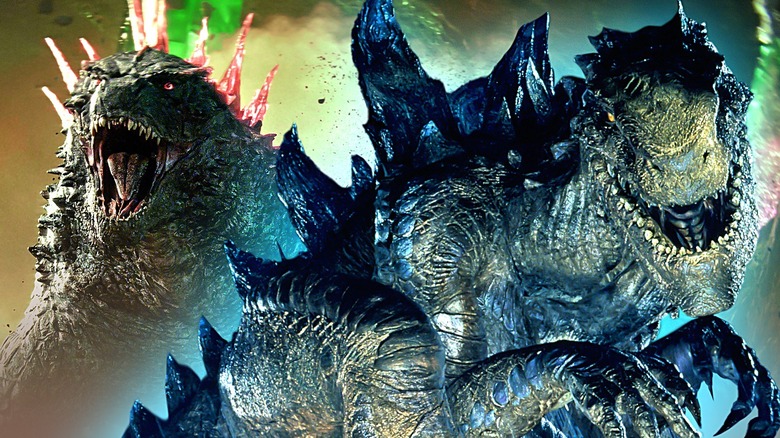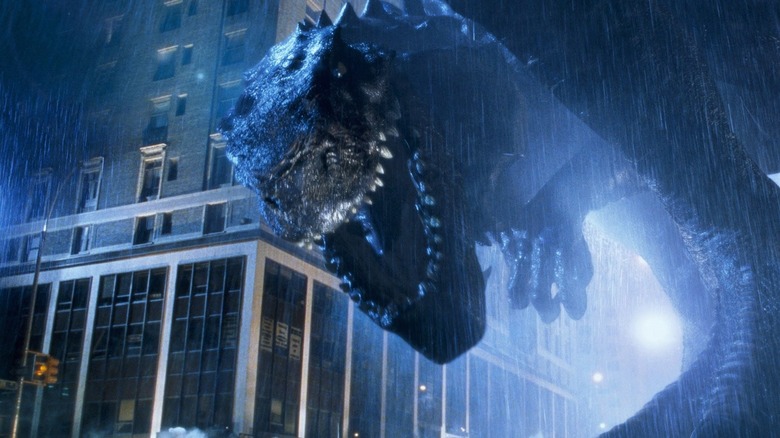
We may receive a commission on purchases made from links.
1998’s “Godzilla” is a complicated beast. It was the first-ever American-produced entry in the legendary franchise, and had a killer marketing campaign that hinged on a less-is-more approach, with the film boasting arguably one of the best teaser trailers of all time. Did the movie live up to the hype? While that’s certainly up to the individual viewer to say, the general consensus is that the film was a major disappointment, both critically and commercially. Despite that, the film’s director felt compelled to defend it — or, at the very least, the controversial redesign of the King of the Monsters.
In a Reddit AMA in 2012, Roland Emmerich decided to field some questions about “Godzilla.” Despite what one thinks about the film, this was a pretty no-holds-barred Q&A featuring the kind of honesty one rarely gets from a big Hollywood filmmaker. For example, when someone asked him why he would make a “Godzilla” movie when he doesn’t even like the monster, Emmerich answered plainly by saying, “The money was good.” Emmerich was coming off of the monster hit that was “Independence Day” and surely earned a good pay day for this one.
The ’98 reimagining of the beloved monster is remembered for completely changing the way the title character looks. Everything we knew about Godzilla was abandoned in favor of something radically different, for better or worse. Someone else in the AMA inquired as to why Emmerich decided to change pretty much everything about Godzilla for the film. His answer was illuminating, if perhaps infuriating for longtime fans:
“I felt that redesigning Godzilla was important to the movie. My vision required a different monster than the overpowered, clunky, indestructible rubber suit that Toho had been using for decades. It was time to give Godzilla a much needed makeover in my opinion.”
Roland Emmerich staunchly defends his version of Godzilla years later
1998’s “Godzilla” has a great many problems, which co-writer Dean Devlin has acknowledged. Those issues go way beyond the character design, but it could easily be perceived as an issue that the film’s director views the most iconic monster to ever grace the silver screen as “clunky” and in such need of a makeover.
Consider the old “If it ain’t broke, don’t fix it” adage. Successful takes on the franchise over the years have largely embraced the classic design as a baseline, but Emmerich threw it all out the window. Doubling down on his thinking, answering another fan in that Q&A, he took a pretty big shot at the classic Toho Godzilla design that dates back to the original 1954 classic:
“My version of Godzilla was realistic. It was sleek, stylish, and it looked intimidating. It was WAY better than that Toho monster.”
Against a massive $150 million budget, Emmerich’s film made $379 million worldwide. One couldn’t call it a flop, but it certainly didn’t live up to expectations, which is why we never got a sequel. It took 16 years for another American take on the franchise to come to fruition. Director Gareth Edwards’ “Godzilla” hit theaters in 2014 and made $529 million worldwide. More importantly, it laid the groundwork for what we now know as the MonsterVerse franchise, which is still going strong.
Say what you will about Edwards’ film, but he embraced what people love about “Godzilla,” which has allowed the franchise to thrive for 70 years. Different takes are welcome when a franchise has gone on this long — just look at 2023’s Oscar-winning smash “Godzilla Minus One.” But in retrospect, it’s wild that a guy who didn’t seem to even care for “Godzilla” was ever given the keys to the kingdom.
“Godzilla” is currently available to rent on VOD, or you can pick up a copy on 4K, Blu-ray, or DVD via Amazon.



Leave a Reply